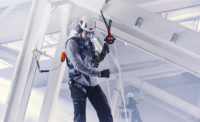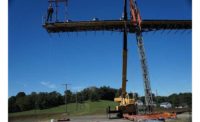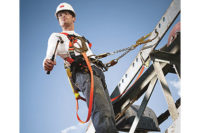No fall protection equipment — regardless of how effective — can save an employee who is not properly trained in its use. Therefore, to maintain a safe and productive environment for workers at height, proper fall protection training is the first and most important step in your fall protection program.
Employees working at height must be thoroughly trained with the knowledge and skills to recognize fall hazards; to evaluate the risk posed by each hazard; and to control the hazard through preventive or protective measures. Each individual must understand these techniques and procedures, including any challenges unique to their company’s procedures, job sites, or tasks.
Don’t rush
With the increasing pressure to get the job done faster, many companies may rush through training requirements to win that next contract, or “check the box.” Ultimately, these companies that take shortcuts end up paying double or more than their initial training investment as a result of having to re-train employees or secure additional contract-appropriate training, or pay damages from fall protection incidents.
It doesn’t pay to cut corners, and it’s important to be trained according the regulatory requirements – not watering it down, or shortening it because it’s easier to do so. It’s time to be a champion of change. The liability, safety, and protection of your workers rely on it.
Safety training
Selecting the right partner to provide the right training is critical. Professional fall prevention and protection training providers must be able to teach essential safety theories as well as their application on a job site so that workers can apply what they’ve learned.
Flexibility in training facilities is key. Check to see if the training company offers open enrollment classes in various locations throughout the U.S. Do they offer state-of-the-art training centers which feature confined space, wind energy, tower and other industry-specific simulators? And are they flexible in offering onsite training programs at your facility or worksite, if that is what you require? Do they have all the proper equipment, including the required backup systems for training?
For some classes, students are asked to bring their own equipment so that during training, they are learning and practicing with the actual products they will use on a daily basis when they return to their jobs. Each student’s equipment, however, should be inspected at training prior to use. If it does not pass acceptable safety standards, the student should not be permitted to use it.
Flexibility in course content is also crucial. The best schools and subject matter expert instructors offer a variety of program options that allow companies to customize their training according to the needs of their employees and the applications and environments in which they will be working.
Some trainers offer half-day, one-day, and two-day classes along with other customized options. ANSI requires workers to return every two years for refresher training. In these classes, it’s entirely up to the employer to decide what content will be reviewed.
The training provider must be able to offer expert guidance as well as customize the training for the students, providing the expertise, leadership, and resources that will deliver the most value to trainees.
Fall protection has some complex technical considerations, and implementing the right approach is a matter of careful engineering. Frequently, the biggest takeaway for many individuals who attend fall protection classes is the realization that there’s so much more to know about fall protection than one had first assumed.
Inspection and maintenance
Beyond training in the skills and use of fall protection equipment, workers at height must also be trained in the proper care and maintenance of their equipment.
Did you know that personal fall protection equipment (PFPE) has specific storage requirements and users need to understand all of the requirements for properly storing and caring for their equipment?
To maintain proper service life and high performance, fall protection products – anchorage connectors, body wear and connecting devices – must be inspected regularly. OSHA requires that fall protection equipment be inspected each time it is used, calling it “Pre-Use.” This means before a worker dons a harness, it must be inspected to determine if anything on the harness is damaged or broken.
Check to see if your training provider offers fall protection equipment inspection services per OSHA’s pre-use inspection and ANSI’s semi-annual and annual recommendations. Qualified experts from your training provider will offer to conduct the inspection on-site at your location or at their location.
Staying ahead of the game
Each year, there are announcements of new and exciting advances in fall protection. Innovations in technology, design, weight, materials and comfort are making life easier and safer on the job, and the equipment is offered in a variety of options, styles, and construction from many sources.
It’s critical that technical training instructors stay educated on fall protection PPE, technology advancements, practices, and regulations if they are to succeed in providing the theory and applications needed to keep workers working safely at height.






